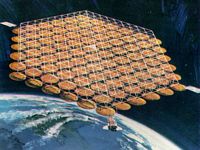 Longtime readers know that I am very interested in how Solar Power Satellites (SPS) might become a viable option for providing clean energy from space. According to the calculations I’ve done, it doesn’t seem like a realistic possibility. The sheer scale of the problem (i.e., how much electricity humanity consumes) means that SPS won’t be more than a minor player on the scene until the efficiencies of Solar-2-Electric conversion get better by at least an order of magnitude (or more).
Longtime readers know that I am very interested in how Solar Power Satellites (SPS) might become a viable option for providing clean energy from space. According to the calculations I’ve done, it doesn’t seem like a realistic possibility. The sheer scale of the problem (i.e., how much electricity humanity consumes) means that SPS won’t be more than a minor player on the scene until the efficiencies of Solar-2-Electric conversion get better by at least an order of magnitude (or more).
 But I still try and follow developments in this field, hoping for some new breakthrough (or hoping that I’ve misplaced a decimal point somewhere). In a recent issue of Marc Boucher’s SpaceRef Daily, he points out a presentation which was given at the George C. Marshall Institute titled “Energy from Space: Examining the Potential of Space to Provide Energy for Earth“. Although I didn’t attend this, the slides from the two presentations are on the Marshall Institute website (and are available here and here).
But I still try and follow developments in this field, hoping for some new breakthrough (or hoping that I’ve misplaced a decimal point somewhere). In a recent issue of Marc Boucher’s SpaceRef Daily, he points out a presentation which was given at the George C. Marshall Institute titled “Energy from Space: Examining the Potential of Space to Provide Energy for Earth“. Although I didn’t attend this, the slides from the two presentations are on the Marshall Institute website (and are available here and here).
Space Elevator fans might take note of slide number 13 from Dr. Hoffert’s presentation. He uses a comparison from Ivan Bekey’s Advanced Space System Concepts and Technologies showing an earth-based Space Elevator operating “40-50 years out” and it’s launch cost as $2/kg (vs. $20,000/kg using a Shuttle today). He also makes the case that SPS could eventually be cheaper than earth based Solar power because of the increased efficiencies.
Neither presentation, unfortunately, deflates the argument I made earlier; that because of the sheer size of the problem, SPS will not be a major contributor to earth’s power usage unless and until efficiencies get a whole let better.
Interesting presentations nonetheless…

It may be viable to send solar energy to places in the Arctic Circle. Satellites orbiting the equator have major problems reaching that far North.
The Artic Circle may be the only place (well, Antartica too) that uses little enough electricity that SPS might be enough 🙂
Eventually everything will be easier in space than on the ground. That’s when power will become primarily spaceborne.